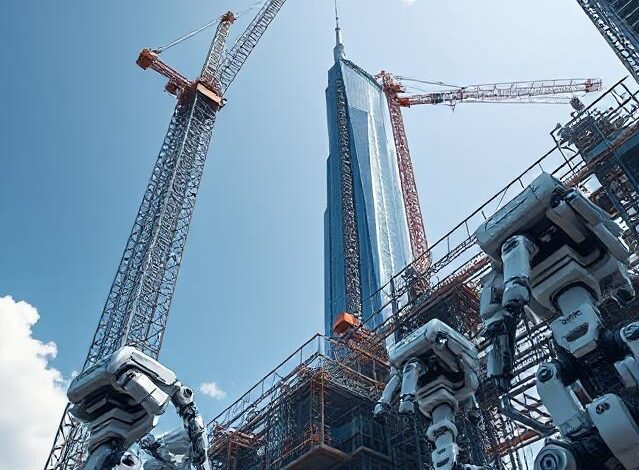Rise of the Robot Communities: Building the Future Together, a concept

In a world where artificial intelligence and robotics have matured beyond isolated functionality, a new era has emerged—one where robots no longer work alone, but as unified communities with shared goals. This idea of “Communities of Robots” draws inspiration from human societies, where collaboration is the backbone of progress. Just like people unite to build cities, explore space, or run governments, robots too are beginning to band together, forming dynamic collectives that can tackle challenges too complex for any single machine.
The Blueprint: Robot Communities in Action
Imagine a massive construction site. Instead of human workers shouting commands and manually coordinating machines, a network of specialized construction robots communicates wirelessly, working in synchronized harmony. Drones survey the site from above, feeding real-time data to ground-based diggers. Precision robots lay the foundation while automated crane bots lift pre-fabricated steel beams into place. All of them are aware of each other’s position, progress, and next steps, thanks to a decentralized but highly coordinated AI-based system. Together, they construct an entire skyscraper in a fraction of the time humans would need—and with far fewer errors.
This is the power of robot communities: a distributed intelligence that mimics the collaborative spirit of human teams, but with the speed, efficiency, and precision of machines.
The Pros: Why Robot Communities Are Game-Changers
1. Scalability and Efficiency:
One robot laying bricks can only do so much. But a hundred working together can build an entire block in a matter of days. Robot communities allow for scalable operations, dividing tasks intelligently and adapting in real-time. This means faster project completion, lower costs, and minimal downtime.
2. Specialization and Synergy:
In these communities, each robot can specialize. Some handle calculations, others logistics, and still others the actual physical labor. This mirrors the human division of labor but with seamless integration. The result is a synergy where the whole is far more capable than the sum of its parts.
3. Resilience and Redundancy:
If one robot fails, others can immediately pick up the slack or call for a replacement. The decentralized nature of robot communities ensures that operations continue smoothly, with minimal disruption.
4. Constant Learning and Adaptation:
As AI improves, robot communities can share knowledge instantly. A construction robot in Tokyo can “teach” a fellow machine in London about a new efficient welding technique. This means the entire global network gets smarter with every experience.
5. Autonomy with Oversight:
Though these communities operate autonomously, they can be monitored and steered by human supervisors when needed. This hybrid model allows humans to focus on strategic oversight rather than micro-management.
The Cons: What Could Go Wrong?
While the vision of robot communities is compelling, it is not without challenges—both technical and ethical.
1. Coordination Complexity:
Managing communication and synchronization across dozens, hundreds, or even thousands of robots is no small feat. Any lag in data sharing, miscommunication, or software bug can lead to chaos—such as a crane lifting a beam too early, endangering the structure or nearby units.
2. Security Risks:
With interconnected systems comes vulnerability. A single hack or software exploit could potentially disrupt an entire robot community. Imagine a rogue actor taking control of a robot fleet tasked with building critical infrastructure.
3. Economic Displacement:
As robot communities take over large-scale tasks—from construction and manufacturing to logistics and even caregiving—the question of human job displacement becomes more pressing. How do we ensure people aren’t left behind?
4. Ethical Boundaries:
If communities of robots begin to make decisions collectively—say, prioritizing certain tasks or resources—who is accountable for the outcome? And what happens when robot communities start to “self-optimize” in ways that conflict with human intentions?
5. Dependence on Infrastructure:
Robot communities require constant connectivity, power, and access to large datasets. Any disruption in this infrastructure—be it from natural disasters or cyberattacks—can bring entire communities to a standstill.
The Human Factor: A New Kind of Collaboration
Despite the risks, the concept of robot communities is not about replacing humans, but augmenting them. Just as we created tools, machines, and eventually computers to extend our capabilities, communities of robots represent the next evolution of teamwork. The key lies in balance—designing systems that complement human strengths while compensating for our limitations.
In fields like disaster recovery, for example, robot communities could search rubble, deliver supplies, and even perform surgeries under remote human supervision. In agriculture, fleets of autonomous machines could monitor crops, apply treatments, and harvest produce with high efficiency. In deep-sea or space exploration, they could operate in hostile environments where human presence is dangerous or impossible.
Conclusion: The Future is Collective
The age of solitary robots is nearing its end. As we move forward, the future belongs to collective intelligence—not just among humans, but among machines as well. Communities of robots have the potential to revolutionize industries, solve massive logistical challenges, and even reshape the way we think about labor and productivity.
But with great power comes great responsibility. We must develop these systems with transparency, security, and ethics in mind. Done right, robot communities could become our greatest allies in building the world of tomorrow—one synchronized step at a time.





